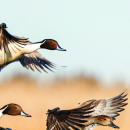Visit Us
This 5,639-acre refuge includes Lake Andes, a 4,700-acre lake created by the last ice age. Each spring and fall, thousands of waterfowl and other waterbirds migrate through this region, taking advantage of the nutritious food found in the wetlands. In addition, many waterfowl find the combination of grasslands and wetlands on this landscape ideal for nesting and raising their young.
Location and Contact Information
About Us
Lake Andes National Wildlife Refuge is a place of wetlands, grasslands, and riverside forests. During spring and fall migrations, clouds of waterfowl and shorebirds darken the sky. Because of its tremendous value to waterfowl and other migratory birds, President Franklin Roosevelt established Lake Andes National Wildlife Refuge with a Presidential Executive Order in 1936. Lake Andes National Wildlife Refuge is somewhat unique as a refuge because most of the lake bottom is owned by the State of South Dakota. However, the State has granted the U.S. Fish and Wildlife Service the authority to manage water levels and maintain habitat for migratory birds and other wildlife.
What We Do
Wildlife conservation is at the heart of the National Wildlife Refuge System. To provide high quality migratory bird habitat on the Owens Bay area of Lake Andes National Wildlife Refuge, staff intensively manage water levels.






